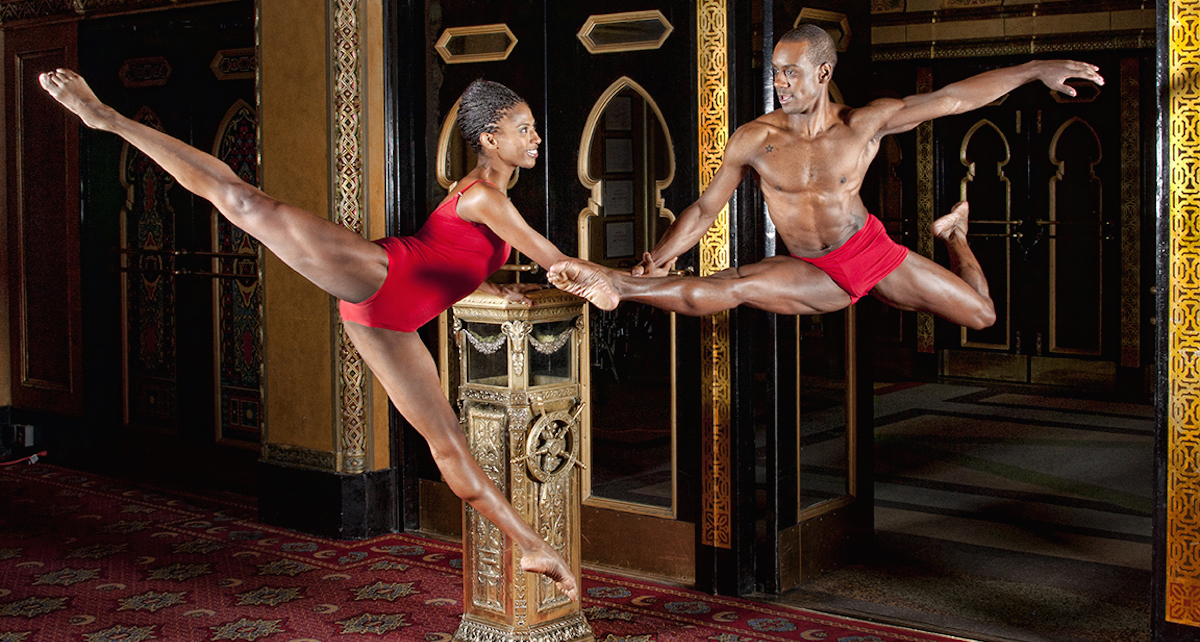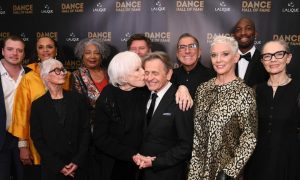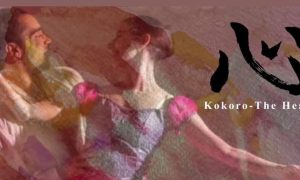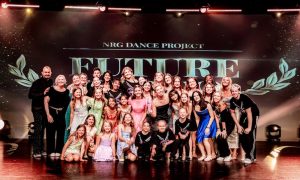In the November 2015 issue of Dance Informa I wrote an article entitled Sound Wisdom. It was designed to help studio teachers and choreographers create more effective tap pieces. I am very gratified with the feedback on that article. Several of the subjects that I touched on in that article pertained to all genres of dance, and the teachers, dancers and choreographers have asked me to elaborate. The equation in the title of this article is dedicated to becoming a complete dancer.
Musician:
In focusing on the dancer as a musician, I want to be clear that it is not absolutely necessary that you, as a dancer, need to play an instrument, sing or even read music, although all of these skills will most definitely help to enhance your musicality. There are many dancers who do not play an instrument or read music but who still have excellent musicality. There’s that word — musicality — which we so often hear in connection with dance…as well we should. The greater majority of dance is performed to music. To be a musical dancer entails much more than staying with the pulse or beat of the music, or just executing the steps on the given count. The goal is for the dancer to attach to the music, for the music to seemingly come out of the dancer’s body and soul. While that’s quite a lofty goal, there are ways to help the dancer improve the ability to attach to the music.
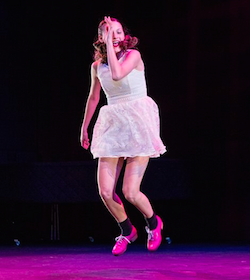
Tapper Devin Ruth. Photo by Karsten Staiger.
The most valuable way to enhance musicianship is the same advice I gave to choreographers in my November article: LISTEN, LISTEN, LISTEN! You can’t attach to music if you aren’t familiar with it. You need to get “married” to the road map and nuances in the music — the verses, choruses and bridges, the dynamics (louds and softs), the accents and the syncopations (off-beat accents). On top of that, a successful performance captures the character and meaning in the lyrics (if there are lyrics). I personally feel that dancers would benefit greatly from working more with instrumental music, whether it’s as simple as just percussion or as heavily orchestrated as a fully produced piece.
One of the areas I find lacking in many dancers (and unfortunately choreographers) is being able to feel and dance in other metres — music counted in other than eights. Two bars of music in 4/4 time is a dancer’s eight; we are so accustomed and comfortable in this groove that we scarcely hear and see anything else. Of particular interest and value to today’s dancers is music in multiples of three. The most recognizable to most people is the waltz. All of us are familiar with the Strauss waltzes used in ballet class for moves such as balancés, or the song “My Favorite Things” from The Sound of Music. These are traditional waltzes with a down, up, up, or “oom, pa, pa”, feel.
These are easy for even beginning dancers to attach to. In pop music, it is more likely to find the three counts grouped in more of a triplet feel. Most of the time, this relates to 6/8 time. An example would be the song “I Miss You” on the Adele 25 album (more pop ballads use a six count than those of faster tempo), and many traditional blues songs are in six as well. Odd metres such as 5/4 time are used far less but create interest and are challenging for dancers. American dancers and audiences find it hard to feel and connect with odd metre grooves. An example of a piece in 5/4 that is recognizable is the theme from Mission Impossible. Dancers who invest in musical understanding and attachment will have a worthwhile edge on their peers and experience more joy in their dancing. A truly musical dancer can be captivating!
Athlete:
No doubt dance is a highly athletic endeavor. It encompasses and implements a range of skills that we have in common with athletes from other sports: spatial awareness, awareness of the other bodies, strength, flexibility, balance, stamina, agility, speed, quickness and power (the ability to combine strength and speed in quick movements). These are all necessary to be a complete dancer.
Dancers have understood that they are athletes, and fortunately, our athleticism is more appreciated by audiences and fellow athletes. I got a kick several seasons ago on Dancing With the Stars when the all-time leading running back from the NFL, Emmitt Smith, said that his time competing on the show was the toughest training he’d ever had to do! That’s quite an endorsement for dancers.
Most of today’s dedicated professional dancers are, of course, continuing their dance training in class, even when they are already working and being paid to perform. The athletic skills gained in class tend to be skill-specific; that is, they train the body for specific dance skills. That’s a worthwhile priority, but to have a longer dance career, especially in a time when people expect the dancer to unload spectacular moves when appropriate, supplemental training has become a necessity. Dance class won’t be enough, particularly for stamina.
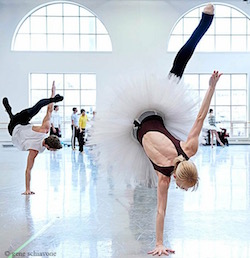
Tiffany Hedman of English National Ballet. Photo by Gene Schiavone.
There are countless forms of supplemental training to enhance the dancer’s conditioning from straight cardio, to weights and machines, yoga, Pilates, kettle bell, aerial work like silks and web, martial arts, Zumba, crossfit forms and many others. A note on weight training: don’t let it scare you and don’t buy into the myth that it will hinder flexibility. If you do a light stretch before lifting, and a thorough stretch after, you’ll be fine. I don’t recommend heavy weights for young dancers whose bodies are still growing, however. In general, dancers don’t need heavy weights; moderate weights with adequate reps will tone, define and give enough strength. Get a qualified trainer to get you on your way.
*Stamina is usually dancers’ weakness in comparison to other athletes. Here are a couple training tips to ensure enough stamina: find a regulation track (400 meters), and run two laps (800 meters) at medium speed — not a sprint but not just a jog. Try to sprint the last 30 yards. This next tip is way valuable: you should be able to execute any dance you will perform twice back-to-back with no rest in between. Your rehearsal should always be more physically demanding than a performance. Final advice: always factor in some rest to your weakly schedule. Take pride in being an athlete!
Artist:
The dancer as an artist. In some ways, this is the most difficult to define and understand, as it is subjective; what is art for one may not be for another. It’s been an eternal dilemma in every art form. As it pertains to dance, the artistic quality of expression is what takes us beyond many other athletes. We can’t just execute movement; we must make it aesthetically effective, pleasing and communicative! In short, we must make it all look great! We loosely wrap this in terms like “expressive” and “exciting”. We take an emotion (all the ranges of emotion) and, hopefully, touch people by giving something inside of us. In a perfect world, the word “inspiration” is our most precious and motivating force. We all find inspiration and creativity in different aspects of life.
I’ve noticed that dancers tend to find their inspiration and motivation within the dance world. While it’s great to be inspired by other dancers, teachers and choreographers, I would encourage you to look outside dance to expand ideas and stimulation. Stay open and aware that there is creativity all around you. While we in dance tend to associate the word “imagination” with the choreographers, the dancer can use imagination to take the character to a place where the dance goes beyond reality to the magic of passion, a word that’s thrown around too lightly but that represents our hearts and souls when authentic.
One exercise that can help the dancer to be less inhibited and less of a “control freak” is to put on music when you’re home alone and no one is watching and simply let your imagination run wild and let it come out of your body with reckless abandon.
Another technique that can enhance your artistry is to visualize or even meditate upon yourself as the perfect dancer — the dancer we would love to watch and love to be — and give that dancer in your mind all the ingredients of a complete dancer: technique, musicality, athleticism, passion, style, inspiration, and, above all, connecting — touching the audience with the joy of a complete dancer!
By Tony Coppola of Dance Informa.
Tap master Tony Coppola is also a former All-American gymnast and a percussionist. He has taught at conventions and judged competitions for several decades. Coppola directs and choreographs the Las Vegas-based Coppola Rhythm Ensemble.
Photo (top): Jacqueline Green and Kirven Douthit-Boyd. Photography by Richard Calmes.


